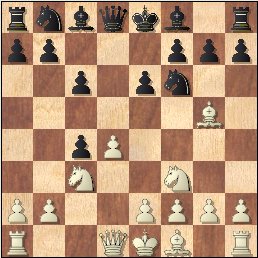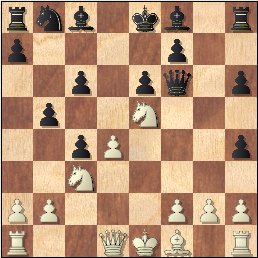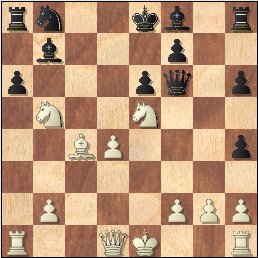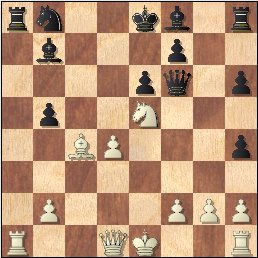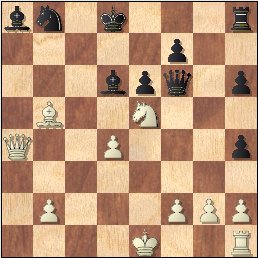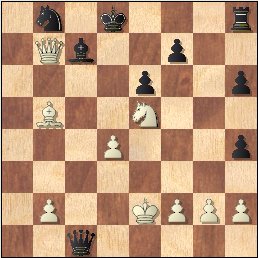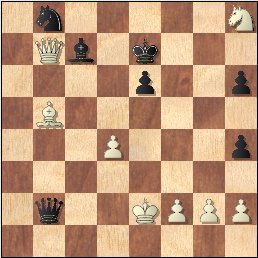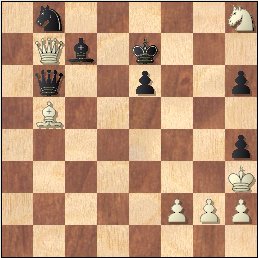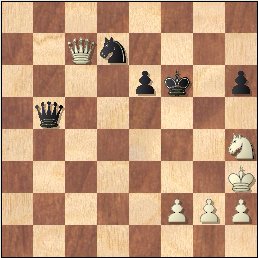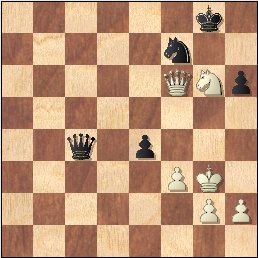GM Ivan Sokolov (2662) - GM Alexei Shirov (2714)
|
|
|
My "GAME OF THE MONTH," ... for {the period of} June 2005.
This is an extremely complicated and interesting struggle. Not only this, it sort of brings my column back into a form of balance. (I have previously shown a few of Sokolov's losses, and this did generate some negative e-mail. Now ... I get to look at one of his wins! Unfortunately, one of my favorite players is "on the wrong end of the stick" at the end of this fight.)
{The ratings are those of FIDE, they are accurate and have been checked against the FIDE website.}
The game starts off as a Queen's Gambit, (declined).
1.d4 d5;
2.c4 c6; {Diagram?}
The Slav, a big favorite of Shirov's - for a long time now.
3.Nf3 Nf6;
4.Nc3 e6;
And now - after Black plays ...e6; shutting in his QB - a true Slav is no longer possible.
(The opening has now become a Semi-Slav.)
[
After the moves:
4...Bf5!?;
5.e3 e6;
{Diagram?}
we reach the positions that signify the lines of the regular Slav Defense.
(Black's QB has been developed outside the Pawn chain.)
See the contest:
GM E. Bareev - GM A. Dreev;
ICT / Corus Master's
(Inv.)
Wijk aan Zee, NED; 2002. (1-0)
{A fantastic struggle ... that went an unbelievable, full 90 moves!}
For more information on these fun and exciting lines, please see
any good reference work. (MCO) ]
5.Bg5 dxc4;
('!?')
Black decides to accept the challenge, and risk one of the sharpest systems in all of chess.
(We enter the dense, dark and scary labyrinths of ... "The Botvinnik / Anti-Slav" Gambit.)
These are not halls that should be trod by the weak, the weary, or the faint of heart!
*************************************
|
|
*************************************
rnbqkb1r/pp3ppp/2p1pn2/6B1/2pP4/2N2N2/PP2PPPP/R2QKB1R
Take a close look at this position.
{See the diagram - given just above here.}
Some of the most difficult and hair-raising complications in all of the double-QP openings ...
can now develop from the current situation that we {now} have on the chess-board.
[
After the 'safer' move of:
5...Nbd7; 6.e3 Be7;
7.Rc1 0-0; 8.Bd3,
"+/=" {D?}
we arrive {transpose} into a
"Queen's Gambit Declined."
(The main lines.) ]
6.e4 b5;
7.e5 h6;
8.Bh4 g5; 9.exf6!?,
Now here is a very interesting wrinkle! (Normally White plays Nxg5 here, on move nine.)
The move actually played in this contest is not one I was intimately familiar with ... at least, not until I began studying this wild frolick!
(Apparently, this idea is very old, its first recorded use was in the Yugoslavian Championship in 1945, where it was played several different games.)
[
The "main lines" of this ultra-sharp continuation are usually reached after the following moves:
(>/=) 9.Nxg5 hxg5; 10.Bxg5 Nbd7;
{Diagram?}
The most standard reply here.
*** *** *** *** *** *** *** *** *** *** *** *** *** *** *** *** *** *** *** ***
(An interesting sideline is: 10...Be7!?; 11.exf6 Bxf6;
12.Be3!? Nd7; 13.Qf3!?, "~" (TN)
with the position being slightly unclear ... or perhaps the first player may hold a slight edge.
GM Alex Yermolinksy (2568) - GM Julio Becerra Rivero
(2537);
National Championship Tournament /
San Diego, CA (USA); 2004.
{Black won a surprisingly sharp game ... in only 32 total moves.}
[ For more information & analysis, see (the) INFORMANT #
92, Game # 423,
beginning on page # 276. ] )
*** *** *** *** *** *** *** *** *** *** *** *** *** *** *** *** *** *** *** ***
11.exf6 Bb7; 12.g3 c5;
13.d5 Qb6; 14.Bg2 0-0-0; 15.0-0,
"~" ("/\" or "+/=") {Diag?}
with continuing complications.
One intriguing example is:
GM Gata Kamsky - GM
Vladimir Kramnik;
ICT / Super-Master (Inv.) /
Dos Hermanas, ESP; 1996.
{This was a tough struggle, that was eventually drawn in 55 moves.}
[ Please {also} see: MCO-14, page # 473; column # 47, and all notes. ]
ALSO!!! Please see my web page
on the game:
Polugayevsky - Torre; Moscow, USSR; 1981.
(It contains a very detailed look at this particular sub-system of this opening.) ]
The next few moves are book.
9...gxh4;
10.Ne5, ('!')
10...Qxf6; {See the diagram given
here ... just below.}
Black is two pawns ahead here, however there is no denying that Black's Pawns are scattered all over the board -
the doubled h-Pawns could be as much as a drawback as a plus here.
*************************************
|
|
*************************************
rnb1kb1r/p4p2/2p1pq1p/1p2N3/2pP3p/2N5/PP3PPP/R2QKB1R
Take a long look at this position ... decide which side of the board that you would rather play here.
One of the world's leading experts - from the Black side of this position - is
GM Sergey Ivanov.
(His name crops up quite a bit in the database ... as does GM Alexei Shirov!)
11.a4!,
(hmmm)
This appears to be White's most vigorous option, although two other moves deserve serious
consideration
at this particular juncture.
[
White can also play:
11.g3!? Nd7!?; 12.Qe2 Bb7;
{Diagram?}
This move might be the best, although several books give 12...Nxe5!? here for Black.
13.Bg2 Bb4; 14.0-0 Bxc3;
15.bxc3 Nxe5; 16.dxe5 Qe7,
"+/=" 17.a4,
"~" "/\" {D?}
When White has some play against Black's rather ugly-looking Pawn skeleton ...
whether or not it will be enough to compensate for the two missing Pawns is open for debate.
(There are NOT very many games in the database with this position, certainly not enough current
games -
between strong masters - to render a really clear theoretical verdict in this position.)
For example, see the contest:
(GM) P. Wells - FM V. Knox;
/ The British Chess Federation
Championship
Blackpool, England; 1988.
{Black won, 0-1 in 36 moves. However,
White misplayed
the whole of the endgame phase.}
**********************************************************************************
White can also play:
11.Be2 Nd7!; 12.Nxc6 Bb7;
13.Bf3 a6!; 14.0-0, {Diagram?}
Normally - you almost never question this move, but here the first player
had something else to consider here as well.
(Worth a look was: 14.Qe2!?, "~" when White has good play.)
14...Bg7!?; 15.a4 b4;
16.Ne4 Qf4; 17.Qc1 Qc7!,
"+/=" {Diag?}
Black is clearly a little better in this position ... and went on to win a nice game.
IM S. Kravtsov - GM
Sergey Ivanov; / The National Champ. Tournament
St. Petersburg; RUS; 1991.
{Black won, 0-1 in 41 moves.}
[ For more information, please see the excellent book:
"The
Botvinnik Semi-Slav," (Copyright) © by IM Steffen Pedersen. (2000)
Published by Gambit Books, Ltd. ISBN: # 1-901983-26-9
(Chapter # 10; see page # 132-134.)
( Black should not play:
</=
17...Qxc1?!; ('?') 18.Nd6+! Kf8; 19.Raxc1 Bxc6;
20.Bxc6 Ra7; 21.Rxc4, "~" (Maybe "+/=")
{Diagram?}
when White has no real problems.
{Analysis by IM Steffen Pedersen.}
) ]
11...Bb7!?;
(fianchetto)
A solid-looking move, that (also) develops a piece for Black.
However, it is not the only move that Black can play in this position.
[ Black can also play:
11...c5!?; 12.Be2 cxd4;
{Diagram?}
The end of the column here.
13.Qxd4 Nd7; 14.Qe4 Rb8; 15.Nc6 Nc5;
16.Qe3, "~" {D?}
... "with chances for both sides." - GM Nick DeFirmian (MCO)
GM J.M. Bellon - GM J. Hector;
ICT / Masters (1-0, 37 moves)
Malmö, SWE; 1996.
[ See MCO-14, page # 471; column # 41, and also note # (r.). ]
************************************************************
Black can also play:
(>/=) 11...Bb4; 12.Be2 Bb7; 13.Bf3 Qe7!?;
{Diagram?}
Placing the QRP on a6 ... was {also} a very good option for Black ...
in this position.
14.0-0 a6; "~" ("=/+")
{Diagram?}
when Black seems to have no real problems here.
J. Hrlbar - M. Vecek;
SLO-ch4, (corr); 1999.
(0-1 in only 27 total moves.)
]
12.axb5, (hmmm)
This might seem like a very obvious move after a4, but White has also played Be2 in this position as well.
[
After the moves:
12.Be2!? c5!?; 13.Nxb5 Na6;
14.0-0!? Rg8; 15.Bf3 Bxf3;
16.Nxf3 Rd8!?;
{Diagram?}
Seemingly a logical move.
** ** ** ** ** ** ** ** ** ** ** ** ** ** ** ** ** ** ** ** ** ** ** **
( Not to be recommended was:
</= 16...cxd4?!; 17.Rc1 Rc8; 18.Nfxd4 Rc5; 19.f4!, '±' {Diag?}
and White went on to win, (1-0); in sixty (60) hard-fought moves.
GM Y. Seirawan - GM J. Pinter; /
(FIDE) Interzonal Tournament
Zagreb, Yugoslavia; 1987.
/ CBM #04 / [GM R. Knaak]
{See also Informant # 44, pg. # 237.}
******************************************************************
Maybe the best idea is: >/= 16...h3!; 17.g3,
"+/=" 17...Rd8!? "<=>" {D?}
with a playable position for Black. (- GM J. Pinter) )
** ** ** ** ** ** ** ** ** ** ** ** ** ** ** ** ** ** ** ** ** ** ** **
17.Rc1,
"~" ("/\")
{Diagram?}
White had good play for the one-pawn deficit.
Carlos Manuel Lopez (2285) - Arian Abreu (2420);
ICT / Andres Clemente Vazquez mem /
Guiines (R3), 15,10,1998. ]
12...cxb5;
13.Bxc4!?,
I am not sure of what to make of this move. ('!!' or '?!' ... or perhaps even something else?)
According to the {games} database, this play (mostly) leads to a draw for White.
[Believe it - or not!]
[
Or White could play:
(</=)
13.Nxb5 Bb4+; 14.Nc3 0-0;
"~" {Diagram?}
with a position that looks to be
OK for Black, who has
an extra Pawn in this position.
(There are no current games, or
any "GM-vs-GM"
contests -
from this position - in the database.) ]
13...a6[];
{Box.}
This appears to be the most prudent course for Black, who wisely decides to decline White's offer on c4.
[
Apparently ... the piece is off limits, terrible things happen to
the second player if he were to take the bait on c4.
For example:
</= 13...bxc4?;
('??')
14.Qa4+ Kd8; 15.Qa5+ Kc8;
{Box?}
I don't think that Black has too much choice in this position.
(Not </= 15...Ke8?; as 16.Qb5+,
"+/-" {Diagram?}
regains the piece in a manner that is extremely favorable to White.)
16.Ra4,
'±' (Maybe "+/-")
"/\" {Diagram?}
with what is probably a winning attack for White. (Work on it!)
]
14.Nxb5!?,
(hmmm) {See
the diagram - just below.}
Once again, I am truly unsure of what type of appellation to award to this move. ('!!' or maybe just '?')
*************************************
|
|
*************************************
rn2kb1r/1b3p2/p3pq1p/1N2N3/2BP3p/8/1P3PPP/R2QK2R
Without a doubt ... this move leads to some really intense tactics.
As for what the exact outcome of this game should have been ... after nearly two weeks of study,
I really cannot say for sure!! (Maybe simply a draw?)
[ Or 14.Be2 h3, "=/+" - Fritz 8.0 ]
14...axb5 [];
(TN)
{See
the diagram - just below.}
Now this move appears nearly obligatory for Black, otherwise White might simply retreat the Knight with a slight edge.
*************************************
|
|
*************************************
rn2kb1r/1b3p2/4pq1p/1p2N3/2BP3p/8/1P3PPP/R2QK2R
It seems very strange, but this very obvious move ... might be completely new to opening theory at this point!
[
After the following moves:
</= 14...Qe7!?;
15.Nc3 h3!?;
16.Qa4+! Nd7?!; 17.Bb5!!,
"+/="
Black has real problems. ('±')
***********************************************************
Black was OK after:
14...Bb4+; 15.Nc3 Bxc3+!?;
{Diagram?}
Castling looked simpler.
16.bxc3 Bxg2; 17.Rg1!? h3;
18.Qa4+ Kf8; 19.Rd1!? Rg8!?;
"~" {D?}
WGM Pia Cramling
(2484) -
IM Axel Ornstein
(2426);
ICT / Master's / Rilton Cup /
Stockholm, SWE (R6); 02,01,2001.
{This was a long game that was eventually drawn in 49 moves.}
Source: TWIC #322.
]
15.Bxb5+
Kd8[]; {Box!}
This is obviously forced, if Black interposes a piece, he gets into even more trouble.
[ </= 15...Nd7??; 16.Bxd7+ Ke7; 17.Bc6, ("+/-") ]
16.Rxa8 Bxa8;
17.Qa4 Bd6!?; {See the diagram
given - just below.}
This looks solid enough - but may turn out to be a dubious concept.
(Maybe Black had to accept the challenge ... and capture on g2.)
*************************************
|
|
*************************************
bn1k3r/5p2/3bpq1p/1B2N3/Q2P3p/8/1P3PPP/4K2R
Black has a tough game ... but seems to be defending fairly well from here.
[
Black might have to bite the bullet, and go ahead and play ...BxP/g2.
17...Bxg2!?; 18.Qa7!! Kc8;
{Diagram?}
Something like this is forced.
(</= 18...Bxh1??; 19.Qxb8+ Ke7; 20.Qc7#.)
19.Bd7+! Nxd7; 20.Qxd7+ Kb8;
21.f3! Bxf3; {Diagram?}
Once again - Black may not have any real choice here.
( Black can NOT try:
</= 21...Bxh1??;
as then White plays 22.Nc6+, {Diag?}
and it is mate next move. ("+/-") )
22.Qb5+! Ka7; 23.Rf1 Qe7!?;
24.Kf2!, '±' (Maybe "+/-")
{Diag?}
and White appears to have a winning attack ("--->") from this position. ]
18.Nc4!?,
(hmmm)
This looks good, and even appears to be {nearly} forced. However, I think it is possible that
Sokolov may have missed a better move here.
[
Maybe White could have played: >/=
18.Qa5+! Bc7[]; 19.Qxa8 Bxe5;
20.dxe5 Qxe5+; 21.Be2,
"+/=" {Diagram?}
when he is clearly better.
(21...QxP/b2?; is easily met by simply castling. Black could not {then}
grab the Bishop
on e2, as this is easily met by QxN/b8+, which
wins material. The computer programs
all favor White from this point. It is
easy to see why, Black's King is sadly exposed.) ]
Now Shirov looks to be just about holding his own from this point in this incredible struggle.
Yet Sokolov will find a way to try and increase the tension - and also the level of the complexities as well!
18...Bc7;
19.Qxa8 Qg5!;
20.Qb7!! Qc1+; 21.Ke2 Qxh1; 22.Ne5 Qc1; ('!')
{See
the diagram - below.}
This might be Black's best bet. {Given the current position.}
*************************************
|
|
*************************************
1n1k3r/1Qb2p2/4p2p/1B2N3/3P3p/8/1P2KPPP/2q5
When
I first went over this game ... I could not understand why Black wasn't just winning here, but White's
powerful threats allow him to regain the Rook. (Please understand that my initial review of this game was
completed in just 2-3 minutes.)
[
The Knight on e5 is untouchable:
</= 22...Bxe5??;
23.dxe5 Qc1!?; 24.Qxb8+ Qc8[]; {Diag?}
One for Ripley's - this is forced.
(</= 24...Ke7!?; 25.Qd6#.)
25.Qd6+ Qd7; 26.Qxd7#.
***********************************************************
Probably an inferior defense is:
</=
22...Rh7!?; 23.Nc6+ Nxc6;
24.Qxc6 Ke7; {Diagram?}
Apparently this is forced, White threatened a mate on d7 AND on the e8-square as well.
( </= 24...Kc8?; 25.Qe8+ Kb7!?; 26.Bc6+ Kb6; 27.Qa8!, "+/-" )
25.Qxc7+ Kf8; 26.Bd3 Rh8;
{Diagram?}
Again this is forced, if Black plays the Rook to g7, the reply is Qd8#.
27.Be4! Rg8; 28.Qd8+ Kg7;
29.Qxh4, "+/="
('±') {Diagram?}
when - according to established endgame theory - White holds the upper hand.
(Bishop plus two Pawns, and lots of threats. And it will be difficult for Black to
find a good square to keep his exposed King from walking into enemy fire.)
]
23.Nxf7+ Ke7;
24.Nxh8 Qxb2+; {See
the diagram given ... just below here.}
Now Black appears to have very nearly brought the game back into a semblance of balance.
*************************************
|
|
*************************************
1n5N/1Qb1k3/4p2p/1B6/3P3p/8/1q2KPPP/8
Of course - you should take a close look at this position and decide for yourself!
** ** ** ** ** ** ** ** ** ** ** ** ** ** ** ** ** ** ** ** ** ** ** ** ** ** ** ** ** ** ** ** ** ** ** **
The next few moves look to
be nearly forced, and/or best for both sides.
25.Kf3! Qc3+;
26.Kg4! Qxd4+; 27.Kh3 Qb6!?; (Maybe - '?!')
{See the diagram given - just below.}
Probably such a super-human defense is taking its toll on Shirov,
the 'knock' on Alexei is that his nerves often bother him
in such difficult situations.
*************************************
|
|
*************************************
1n5N/1Qb1k3/1q2p2p/1B6/7p/7K/5PPP/8
Now Sokolov refuses the swap of the ladies, in order to stay on the offensive here.
[ >/= 27...Qc5!; 28.Bd3, "+/=" ]
The next few moves ... seem to be all pretty much best ... at least, from the current position on the board.
28.Qc8! Qxb5;
29.Qxc7+ Nd7;
30.Ng6+ Kf6; 31.Nxh4, "+/=" {See
the diagram ... just below.}
White now has won a button ... and holds all the cards here. (Maybe - '±')
*************************************
|
|
*************************************
8/2Qn4/4pk1p/1q6/7N/7K/5PPP/8
This
position deserves a diagram, it seems a {minor} miracle ... that after all the complications, (and sacrifices!);
Sokolov should emerge a Pawn up, with realistic chances to win the game.
[ 31.Nf4!? Qf5+; ("=") ]
The next few moves are close to absolute best - verified by the computer - and really needs no commentary at all (from me).
31...Qd3+;
32.f3 Ne5; 33.Qc1!? Nf7; 34.Qb2+ e5?!; (Time pressure?)
This is very clearly wrong, Black should play 34...Ne5; which is an offer to repeat the position.
Then the onus would be on White to demonstrate any real
advantage.
35.Qb6+! Kg7;
It could be that Black should try to interpose the Queen, the resulting endgames,
{after a trade of the most powerful piece} would seem to be relatively drawish.
36.Kg3,
(hmmm)
White plays the most solid move, (but perhaps not the most
aggressive).
[
Also possible was the interesting
(>/=) 36.Kg4!?,
"+/=" ('!') (Maybe "+/")
when White is clearly better. ]
36...Qc4?;
(Maybe - '??')
This is very clearly a bad move ... in a position that is already miserable
for Black. Yet, the position was not totally decided in White's favor; but
after this play, it is all downhill from here to the finish line for Sokolov.
(36...Nd8[]; was probably the best defense for Black here; 36...Ng5!? was also better than the move that
was actually played in the game here.)
[ 36...Qd2!?; 37.Qg6+ Kf8!; 38.Qf6 Kg8; 39.Kg4!, '±' ]
37.Qg6+ Kf8;
38.Qf6 Kg8[];
According to Fritz - this was best.
39.Ng6! e4!?;
('?!') {See
the diagram given - just below here.}
A panic reaction by Black?
*************************************
|
|
*************************************
6k1/5n2/5QNp/8/2q1p3/5PK1/6PP/8
The end of this game has all the earmarks of a bad time scramble.
[
The move of:
>/= 39...Qb4!;
{Diagram?}
was a slightly better defense for
Black in this position.
******************************************************
However, Black can NOT play:
</= 39...Qd3?;
40.Qxf7+! Kxf7; 41.Nxe5+, {Diagram?}
and White wins back the Queen ... with a decisive advantage.
("+/-")
(A tactical sequence like this is common in positions like this -
the
student should be on the lookout for this type of combo.
Knights
are the best pieces for setting up a sneaky fork!)
]
40.Nf4!? exf3??;
(OUCH!!)
Very clearly a blunder by Alexei, and after White's reply - Shirov
would have to give up the Queen to prevent the mate.
[
Instead, after the following moves:
>/= 40...Kf8[];
41.Ne6+ Ke8; 42.Ng7+ Kf8; 43.Nf5 exf3;
44.gxf3 Qc5;
45.Qg7+ Ke8; 46.Qg8+ Qf8;
47.Qxf8+ Kxf8; 48.f4,
'±' (Maybe "+/-") {D?}
White is very close to winning, but
I would want to fight it out ... right down to the
bitter end. (There are quite a bit of natural, inherent
drawing possibilities in any
simplified endgame such as this.) ]
41.Ne6,
("+/-") [Resigns.]
There was no reason to continue.
A great game by GM Ivan Sokolov.
After a seeming slump, he is back on top of the world ...
he tied for first, (with GM Vicktor Bologan); at this grand tournament.
Copyright (c) A.J. Goldsby, 2005. All rights reserved.
***************************************************
All pages - the
games and analysis - were originally generated with the program, ChessBase
8.0 and CB 9.0.
The diagrams on this page were generated with the use of the
program, ChessCaptor
2.25, (or CB 9).
The web page was prepared and polished with the excellent
program, Microsoft FrontPage. (FP
2000)
***************************************************
1 - 0
Further Reference:
-
Please see my web page on the game, Polugayevsky - Torre; Moscow, USSR; 1981.
(It contains a very deep look at the main <book> lines of the Botvinnik Gambit.) -
Please {also} see my web page on the game:
GM Garry Kasparov - GM Alexey Dreev; 57th National Championship / Moscow, RUS; 2004.
(It contains a very detailed look at the "Moscow Variation," which is also a closely related opening system or variation.)
